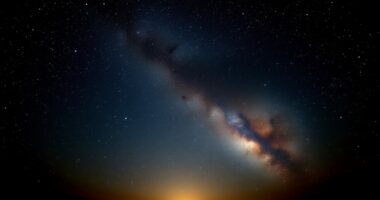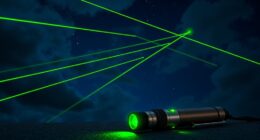If you’re looking to elevate your night photography, I recommend checking out star trackers like the Sky-Watcher Star Adventurer 2i Pro Pack and the iOptron SkyGuider Pro, which support DSLR cameras and offer precise tracking for stunning shots. These models are portable, easy to control via Wi-Fi, and compatible with various accessories like counterweights and polar finders. Stay with me, and you’ll discover which options best suit your needs and budget.
Key Takeaways
- Look for lightweight, portable star trackers compatible with DSLR cameras for easy outdoor setup and travel.
- Prioritize models with Wi-Fi or app control for convenient remote operation and precise tracking adjustments.
- Choose trackers supporting payloads up to 11 lbs to accommodate your DSLR and small accessories.
- Consider units with built-in polar finderscope and adjustable mounts for accurate polar alignment.
- Opt for durable, all-metal gear systems and quality build to ensure long-term reliability and smooth tracking.
Sky-Watcher Star Adventurer 2i Pro Pack Night Sky Tracker

If you’re new to astrophotography or want a portable, reliable tracker to elevate your night sky images, the Sky-Watcher Star Adventurer 2i Pro Pack is an excellent choice. It transforms nearly any tripod into an accurate, high-precision tracking platform, supporting long exposures for stunning astrophotos, nightscapes, and time-lapses. Weighing just 2.4 pounds but supporting up to 11 pounds, it’s perfect for travel and small setups. Its all-metal gears ensure durability, while Wi-Fi connectivity allows smartphone control via the SAM Console app. The modular design and optional accessories make it versatile, and with proper setup, it delivers dependable, sharp tracking for both beginners and experienced astrophotographers.
Best For: amateur and beginner astrophotographers seeking a portable, easy-to-use tracking solution for night sky photography and time-lapse videos.
Pros:
- Lightweight and portable, ideal for travel and outdoor use
- Supports long-exposure astrophotography with up to 11-pound payload capacity
- Wi-Fi connectivity and smartphone control via SAM Console app for ease of operation
Cons:
- Polar alignment can be tedious due to limited built-in lighting
- Mechanical issues or firmware glitches may require updates or maintenance
- Not suitable for large or heavy telescopes, limiting use for advanced astrophotography
Sky-Watcher Star Adventurer Photo Kit – Night Sky Tracking Mount for DSLR Imaging

The Sky-Watcher Star Adventurer Photo Kit stands out as an excellent choice for amateur and hobbyist astrophotographers seeking a portable, reliable tracking mount for DSLR cameras. Weighing just 2.4 pounds with an 11-pound payload, it transforms standard tripods into precise tracking platforms for long-exposure astrophotography, including Milky Way shots, eclipses, and panoramas. The upgraded 2i version offers Wi-Fi control via a smartphone app, built-in polar finderscope, and rugged gears for smooth tracking. Its modular design supports wide-field imaging, telescopic use, and accessories like equatorial wedges. Despite some app and polar scope limitations, many users find it easy to set up and produce professional-quality images.
Best For: amateur and hobbyist astrophotographers seeking a portable and versatile tracking mount for DSLR cameras to capture wide-field night sky images and celestial events.
Pros:
- Lightweight and portable at only 2.4 pounds, making it easy to carry and set up in the field.
- Supports long-exposure astrophotography with up to 3-4 minute exposures, producing sharp images of the night sky.
- Wi-Fi connectivity and smartphone app control for convenient operation and alignment.
Cons:
- Polar scope and app usability issues can complicate polar alignment for beginners.
- Occasional quality control problems, including damaged units and limited accessory availability.
- Some users experience software compatibility and update challenges, requiring beta apps or alternative solutions.
Sky-Watcher Star Adventurer 2i Astro Pack – Night Sky Tracker with Remote Camera Control
The Sky-Watcher Star Adventurer 2i Astro Pack stands out for astrophotographers who need precise, motorized tracking with remote camera control. Its modular design easily attaches to standard tripods, making setup straightforward. Built with durable brass and aluminum gears, it ensures smooth, reliable movement. Weighing just 2.4 pounds, it’s lightweight and portable—perfect for on-the-go astrophotography. The illuminated polar finderscope helps with accurate alignment, while the built-in AA battery offers up to 72 hours of power. Plus, its support for most DSLR cameras with an 11-pound payload and remote control capabilities makes it a versatile tool for capturing stunning night sky images.
Best For: amateur and professional astrophotographers seeking a portable, precise motorized sky tracker with remote camera control for wide-field and telescopic astrophotography.
Pros:
- Modular design compatible with standard tripods for easy setup.
- Rugged construction with brass and aluminum gears ensures smooth, reliable tracking.
- Long-lasting power with up to 72 hours of operation via built-in AA batteries.
Cons:
- Limited payload capacity of 11 pounds may restrict heavier camera and lens combinations.
- Requires accurate polar alignment, which may be challenging for beginners.
- External power options depend on additional accessories like mini-USB chargers.
Sky Watcher Star Adventurer GTI Mount Kit with Counterweight and CW Bar

For astrophotographers seeking a portable, full-featured mount that simplifies long-exposure imaging, the Sky Watcher Star Adventurer GTI Mount Kit with Counterweight and CW Bar stands out. It offers precise GoTo equatorial tracking in a compact design, with features like a built-in illuminated polar scope, Wi-Fi, USB, and autoguider ports. Supporting up to 11 pounds, it’s suitable for DSLR/mirrorless cameras, small telescopes, and astrographs. The dual-position counterweight bar enhances balance, especially at low latitudes. While setup is straightforward and tracking accurate, some users report quality issues like loose parts or defective components. Overall, it’s a versatile, portable option for serious astrophotographers.
Best For: amateur astrophotographers seeking a portable, full-featured mount capable of precise tracking and easy setup for deep-sky, lunar, and planetary imaging.
Pros:
- Compact, lightweight design ideal for field and travel use
- Full GoTo functionality with Wi-Fi connectivity and polar alignment features
- Supports multiple tracking modes and up to 11 pounds payload, suitable for cameras and small telescopes
Cons:
- Occasional quality issues, such as loose parts or defective components
- Some users experience app connectivity or alignment accuracy problems
- Build quality can vary, with reports of plastic parts and assembly inconsistencies
iOptron SkyGuider Pro Camera Mount Full Package

If you’re passionate about capturing sharp, long-exposure astrophotography, the iOptron SkyGuider Pro Camera Mount Full Package stands out as an excellent choice for portable and reliable star tracking. Its all-metal construction and precise machining provide exceptional stability, minimizing vibrations that cause blurry images. Weighing just 2.2 pounds, it’s lightweight and easy to carry in a camera bag. Supporting up to nearly 12 pounds, it’s versatile for various setups. The adjustable Alt-Azi base with latitude and azimuth controls makes alignment quick and accurate, especially with the integrated illuminated polar scope, ensuring precise tracking during long exposures.
Best For: amateur to professional astrophotographers seeking a portable, stable, and precise star tracking mount for long-exposure astrophotography.
Pros:
- All-metal construction and precise machining ensure superior stability and minimal vibration during imaging.
- Lightweight design at 2.2 lbs makes it highly portable for on-the-go astrophotography sessions.
- Adjustable Alt-Azi base with integrated illuminated polar scope provides quick and accurate polar alignment even in low-light conditions.
Cons:
- Supports up to 11 lbs, which may limit heavier or more complex camera/lens setups.
- Limited azimuth adjustment of ±5°, potentially requiring additional fine-tuning for certain polar alignments.
- The compact design may require additional accessories for very advanced astrophotography configurations.
Sky-Watcher Star Adventurer Mini Pro Pack – Motorized DSLR Night Sky Tracker
Aspiring astrophotographers seeking a portable, user-friendly tracker will find the Sky-Watcher Star Adventurer Mini Pro Pack to be an excellent choice. This compact, motorized platform transforms almost any tripod into an accurate equatorial mount, perfect for capturing the Milky Way, eclipses, and nightscapes. Controlled via WiFi with the free SynScan app, it offers customizable tracking modes and easy panning. The package includes essential accessories like an illuminated polar scope and an equatorial base for precise polar alignment. With a lightweight design and up to 24 hours of battery life, it’s ideal for travelers and hobbyists wanting reliable, long-exposure astrophotography without breaking the bank.
Best For: amateur astronomers and hobbyists seeking a portable, easy-to-use astrophotography tracker for capturing the Milky Way, eclipses, and nightscapes during travel or outdoor adventures.
Pros:
- Compact, lightweight design ideal for travel and outdoor use
- WiFi control via free SynScan app with customizable tracking modes
- Includes essential accessories like polar scope and equatorial base for precise alignment
Cons:
- Occasional connectivity issues and app complexity reported by users
- Some users experience mechanical stability concerns or shaky tripod support
- Limited detailed instructions in the manual can make setup challenging for beginners
iEXOS-100-2 PMC-Eight Astrophotography Tracker System Tripod and Mount
The iEXOS-100-2 PMC-Eight Astrophotography Tracker System stands out with its advanced PMC-Eight technology, which uses eight independent CPUs to deliver precise and responsive control during astrophotography sessions. This multi-processor setup guarantees smooth, efficient operation and highly accurate tracking of celestial objects. Its mechanical design features quiet, dual-axis worm gears driven by stepper motors, providing smooth movement and easy balancing. The system’s polar alignment is quick and straightforward thanks to built-in alignment features, eliminating the need for a polar scope. Controlled via the ExploreStars app with WiFi and Bluetooth, it offers intuitive operation and seamless remote control, elevating your night sky photography.
Best For: amateur and professional astrophotographers seeking a highly responsive, precise, and easy-to-use tracking system for night sky imaging.
Pros:
- Utilizes advanced PMC-Eight technology with eight independent CPUs for superior responsiveness and control.
- Features quiet, smooth dual-axis worm gears driven by stepper motors for stable tracking and easy balancing.
- Offers quick and accurate polar alignment without the need for a polar scope, simplifying setup.
Cons:
- May be more expensive than simpler tracking mounts, making it less accessible for casual users.
- Requires familiarity with the ExploreStars app for optimal operation, which may have a learning curve.
- Wireless connectivity options (WiFi and Bluetooth) depend on device compatibility and may occasionally experience connectivity issues.
DSLR Night Tracker Equatorial Mount for Astrophotography

For astrophotographers seeking precise and reliable tracking, the DSLR Night Tracker Equatorial Mount stands out due to its adjustable 90-degree angle feature. This flexibility allows me to fine-tune the mount’s position from horizontal to vertical, ensuring ideal alignment for various celestial targets, solar imaging, or star field observations. Made from durable aluminum alloy, it offers smooth adjustments and long-lasting performance. Its universal 3/8-inch threaded base makes attaching it to most tripods simple and secure. The design simplifies axis alignment, enhances portability, and supports a wide range of equipment, making it an excellent choice for both amateurs and professionals.
Best For: amateur and professional astrophotographers seeking a reliable, adjustable mount for precise celestial tracking and imaging.
Pros:
- Made from durable aluminum alloy for long-lasting performance
- Flexible 90-degree adjustable angle for versatile positioning
- Universal 3/8-inch threaded base allows easy attachment to most tripods
Cons:
- May require additional accessories for specific telescopes or cameras
- Slight learning curve for optimal axis alignment
- Heavier than some portable alternatives, which might affect travel convenience
Sky-Watcher AZ-GTI Portable WiFi-Enabled GoTo Alt-Az Mount

If you’re looking for a highly portable and easy-to-use mount that combines modern technology with reliable tracking, the Sky-Watcher AZ-GTI is an excellent choice. Weighing just 8.6 pounds, it’s perfect for quick setup and travel. The included adjustable tripod extends from 28 to 53 inches, offering flexible viewing angles. It supports payloads up to 11 pounds, making it suitable for most DSLR cameras and small telescopes. Its WiFi-enabled system allows control via smartphone or tablet, and the dual-encoder “Freedom Find” technology guarantees accurate tracking even during manual adjustments. Plus, the built-in SNAP port simplifies automated shooting for time-lapse and panoramas.
Best For: amateur astronomers and astrophotographers seeking a portable, WiFi-controlled mount for quick setup and precise tracking during travel or outdoor observations.
Pros:
- Lightweight and compact at only 8.6 pounds, ideal for portability and travel.
- Supports payloads up to 11 pounds, accommodating most small telescopes and DSLR cameras.
- WiFi-enabled with app control and dual-encoder “Freedom Find” technology for accurate manual and automatic tracking.
Cons:
- Limited payload capacity may not suit larger telescopes or heavy accessories.
- Requires a compatible smartphone or tablet for control, which may be inconvenient for some users.
- External power source needed for extended use beyond battery life.
Latitude Adjustment Seat for Astronomical Observations

A latitude adjustment seat is essential for anyone aiming to achieve precise celestial tracking, especially when using star trackers with DSLR cameras. It allows me to easily set my mount’s angle to match my observing location’s latitude, ensuring accurate polar alignment. Made from durable aluminum, it’s lightweight yet sturdy, supporting cameras, telescopes, and trackers without adding bulk. The 0°-90° adjustment via a smooth threaded knob makes framing stars or landscapes effortless. Compatible with standard tripods, it offers quick setup and reliable stability. Whether I’m capturing deep-sky images or time-lapses, this seat helps me achieve sharper, more precise shots with minimal fuss.
Best For: Amateur and professional astronomers, astrophotographers, and solar imaging enthusiasts seeking precise, quick polar alignment and stable support for celestial and landscape photography.
Pros:
- Made from durable, lightweight aluminum alloy for longevity and easy handling
- Precise 0°-90° adjustment with a smooth threaded knob for effortless positioning
- Compatible with standard tripods and supports a variety of cameras, telescopes, and trackers
Cons:
- Price and availability may vary across different online and offline retailers
- First available date listed as April 9, 2025, which may be a future or incorrect date
- Limited to 3/8 inch threading, requiring additional adapters if using other mounting standards
Tripod Leveler Stand with Adjustment Bracket

The Tripod Leveler Stand with Adjustment Bracket stands out with its +/-5 degree precision adjustment, making it ideal for photographers who need quick and accurate leveling during astrophotography, panoramic shots, or video shoots. Its tri-wheel leveling base allows smooth, fingertip adjustments, while built-in bubble levels ensure accuracy. Compatible with Seestar S50, various heads, and tripods, it’s made from lightweight aircraft-grade aluminum for durability without adding weight. The CNC-machined, anti-oxidation surface guarantees long-term stability. Supporting up to 15 kg (33.1 pounds), it’s perfect for outdoor use, providing stability, precision, and portability for both hobbyists and professionals.
Best For: photographers and videographers seeking precise and quick leveling solutions for astrophotography, panoramic shots, and outdoor shoots.
Pros:
- Enables smooth, fingertip adjustments with tri-wheel leveling base for high accuracy
- Built-in bubble levels aid in quick and precise setup
- Lightweight aircraft-grade aluminum construction offers durability without added weight
Cons:
- Supports a maximum load of 15 kg (33.1 pounds), which may be limiting for some heavy rigs
- Slightly higher price point compared to basic leveling accessories
- Requires manual adjustment and locking, which may take time during rapid shoot setups
Factors to Consider When Choosing Star Trackers for DSLR Cameras

When selecting a star tracker for my DSLR, I focus on its payload capacity to guarantee it can handle my gear. I also consider compatibility, ease of polar alignment, and power options for convenience during long shoots. Finally, portability and size matter to me for easy transport and setup in different locations.
Payload Capacity Limits
Choosing a star tracker with the right payload capacity is essential to guarantee your DSLR setup tracks accurately without risking damage. You need to verify the tracker’s maximum payload exceeds your camera, lens, and any accessories’ combined weight. Overloading a tracker beyond its specified limit can cause inaccurate tracking, mechanical wear, or even damage the device. Pay attention to the listed capacity in pounds or kilograms, and always add a safety margin to account for any future gear upgrades. Using a payload close to the maximum limit can reduce tracking precision and increase the risk of mechanical failure. To keep things reliable and safe, aim for a tracker with a capacity comfortably above your current setup, providing a buffer for added equipment or future changes.
Compatibility With Equipment
Selecting a star tracker that supports your DSLR setup involves more than just considering its payload capacity. You need to guarantee it’s compatible with your camera’s mounting system, such as standard V-style dovetails or T-threads for small telescopes. Verify that the tracker’s power options, like AA batteries or external USB, match your preferred source for reliable, long sessions. It’s also important to check if it includes or supports accessories like polar scopes, wedge adapters, or mount plates suited for your equipment. Additionally, confirm that the control interface—whether Wi-Fi, an app, or manual controls—is compatible with your smartphone or remote controls. These factors ensure smooth operation and prevent compatibility issues that can disrupt your night photography sessions.
Ease of Polar Alignment
A star tracker with an easy-to-use polar alignment process can substantially cut down setup time and boost tracking accuracy for DSLR astrophotography. Built-in illuminated polar finderscopes or polar scopes make locating Polaris or other celestial poles straightforward, saving time and reducing frustration. Some models feature automatic or semi-automatic alignment options, which are perfect for beginners, as they help achieve precise alignment with minimal effort. Fine adjustment controls like slow-motion knobs or adjustable wedges allow for more accurate positioning, especially when fine-tuning is necessary for long exposures. Since even small misalignments can cause star trails or blurry images, choosing a tracker with simple, effective alignment features guarantees better results and a smoother shooting experience.
Power Supply Options
Power supply options are a critical factor when selecting a star tracker for DSLR astrophotography, as they directly impact how long and how reliably you can shoot under the night sky. Many trackers support multiple power sources, like AA batteries, rechargeable lithium-ion packs, or external power through USB or DC adapters. The choice of power supply influences operational duration—some units can run up to 72 hours on a single battery set. External inputs, such as 5V mini-USB or 12V DC, enable continuous operation for extended sessions. Battery type and capacity also matter; lightweight AA batteries are great for portability, while larger rechargeable packs provide longer runtimes. Features like low-battery warnings and automatic shutdowns help ensure reliable, uninterrupted shooting and protect your data during long exposures.
Portability and Size
When choosing a star tracker for DSLR astrophotography, portability and size play a significant role in ensuring you can take it anywhere without hassle. Compact trackers weighing under 3 pounds are ideal for travel and outdoor sessions, allowing you to carry them easily in backpacks or camera bags. Most small models measure less than 15 inches, making packing straightforward and storage simple. Many feature foldable or modular designs, which further ease transportation and setup. Lightweight trackers support payloads suitable for DSLR cameras and small lenses, so you don’t have to compromise mobility for performance. Their manageable size also makes quick polar alignment and setup in the field much easier, enabling you to maximize your night photography adventures without being bogged down by bulky equipment.
Control and Connectivity
Choosing the right star tracker means paying close attention to its control and connectivity options, as these features directly impact ease of use and reliability during your astrophotography sessions. I look for models with reliable Wi-Fi or Bluetooth so I can control my tracker remotely via my smartphone or tablet. Compatibility with user-friendly control apps is essential, especially if they offer tracking speed adjustments and access to celestial object databases. I also consider the stability and range of the wireless connection, since interference can disrupt sessions. Firmware update capabilities through the app are a plus, ensuring my device stays current and bug-free. finally, I prefer trackers that support external power sources, like USB or batteries, to keep connectivity steady during long shoots.
Tracking Accuracy and Stability
Achieving precise tracking and stable images hinges on a star tracker’s mechanical design and setup. High tracking accuracy depends on a mount with precise motor control and minimal backlash, ensuring star trails stay within acceptable limits during long exposures. Stability relies on a sturdy tripod and a well-balanced setup; vibrations or shifts can undermine tracking precision and image sharpness. Proper polar alignment is essential—any misalignment causes drift and inaccuracies. Mounts equipped with advanced guiding features or autoguider ports can further enhance stability by compensating for mechanical imperfections. Regular maintenance, like tightening gears and checking tension, helps sustain consistent accuracy over time. Together, these factors guarantee your star tracker delivers the stability and precision needed for stunning night photos.
Price and Budget
Star trackers for DSLR cameras come in a wide range of prices, from affordable entry-level models around $200 to high-end units exceeding $1000. Setting a budget helps you focus on essential features like tracking accuracy, payload capacity, and necessary accessories. Higher-priced trackers usually offer better build quality, more precise motors, and longer battery life, making them a good choice for serious astrophotographers. On the other hand, budget-friendly options may lack advanced features such as Wi-Fi control or autoguider ports but still deliver excellent results for beginners. It’s also important to take into account your overall astrophotography budget, including lenses and accessories, to guarantee your star tracker purchase remains financially feasible. Balancing cost with your needs is key to making the right choice.
Frequently Asked Questions
How Do Star Trackers Improve Astrophotography Quality?
Star trackers improve astrophotography by compensating for Earth’s rotation, allowing my camera to stay perfectly aligned with the stars. This means I can capture long-exposure shots without star trails, resulting in sharper, more detailed images. They also help me gather more light and reveal fainter celestial objects. With a good star tracker, I feel confident that my night shots will be clearer and more stunning, elevating my entire astrophotography experience.
What Is the Typical Lifespan of a Star Tracker Device?
A star tracker’s lifespan is like a well-worn but reliable compass, often lasting between 3 to 10 years with proper care. I’ve found that quality devices tend to endure longer, especially if I avoid harsh weather and keep them well-maintained. Regular calibration and gentle handling can extend their life, making them a valuable investment for capturing stunning night skies.
Are Star Trackers Compatible With All DSLR Camera Brands?
Star trackers aren’t universally compatible with all DSLR brands, but most are designed to work with common camera mounts like Canon and Nikon. I always check the tracker’s specifications to guarantee it supports your camera’s mount type. If you have a less common brand, you might need an adapter. I recommend researching specific models to confirm compatibility before making a purchase, so you can enjoy seamless night photography sessions.
How Much Experience Is Needed to Operate Star Trackers Effectively?
I’d say you don’t need much experience to operate star trackers effectively. When I started, I just took some time to read the instructions and practice setting up in my backyard under a star-lit sky. Once you get the hang of aligning the tracker, capturing stunning long-exposure shots becomes almost second nature. It’s like riding a bike—initially tricky, but with a little patience, it becomes smooth and rewarding.
Can Star Trackers Be Used for Planetary or Lunar Photography?
Yes, star trackers can be used for planetary and lunar photography, but they’re not always ideal. I’ve found they work best for deep-sky objects rather than planets or the moon, which require specialized tracking for fast-moving targets. If you want detailed planetary shots, consider a mount designed for high-speed tracking. Still, with some adjustments, star trackers can capture impressive lunar images, especially if you’re just getting started.
Conclusion
In my experience, the right star tracker can truly transform your night photography, making the stars dance perfectly in your shots. Whether you’re a beginner or a pro, choosing the best one can feel overwhelming, but trust me, the difference it makes is like opening a portal to the universe itself. So go ahead, pick your ideal tracker, and prepare to capture the cosmos in ways you never thought possible—your night photos will never be the same!








